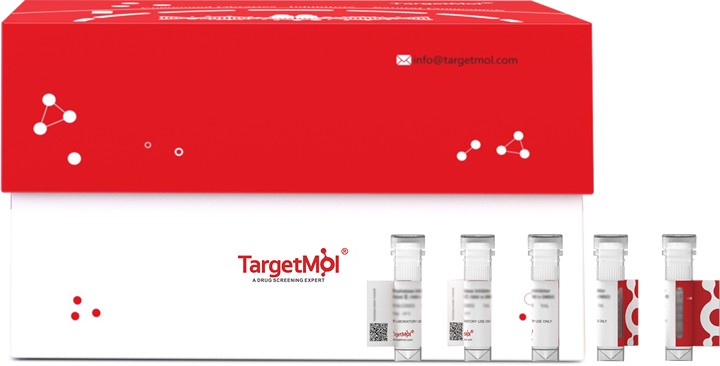- 全部删除
 您的购物车当前为空
您的购物车当前为空
Rotavirus X (isolate novel adult diarrhea rotavirus-B219) VP4 Protein (His)
Spike-forming protein that mediates virion attachment to the host epithelial cell receptors and plays a major role in cell penetration, determination of host range restriction and virulence. Rotavirus attachment and entry into the host cell probably involves multiple sequential contacts between the outer capsid proteins VP4 and VP7, and the cell receptors. It is subsequently lost, together with VP7, following virus entry into the host cell. Following entry into the host cell, low intracellular or intravesicular Ca(2+) concentration probably causes the calcium-stabilized VP7 trimers to dissociate from the virion. This step is probably necessary for the membrane-disrupting entry step and the release of VP4, which is locked onto the virion by VP7.; Forms the spike 'foot' and 'body' and acts as a membrane permeabilization protein that mediates release of viral particles from endosomal compartments into the cytoplasm. During entry, the part of VP5* that protrudes from the virus folds back on itself and reorganizes from a local dimer to a trimer. This reorganization may be linked to membrane penetration.; Forms the head of the spikes and mediates the recognition of specific host cell surface glycans. It is the viral hemagglutinin and an important target of neutralizing antibodies.

Rotavirus X (isolate novel adult diarrhea rotavirus-B219) VP4 Protein (His)
| 规格 | 价格 | 库存 | 数量 |
|---|---|---|---|
| 20 μg | ¥ 2,570 | 20日内发货 | |
| 100 μg | ¥ 5,370 | 20日内发货 | |
| 500 μg | ¥ 12,300 | 20日内发货 |
产品信息
| 生物活性 | Activity has not been tested. It is theoretically active, but we cannot guarantee it. If you require protein activity, we recommend choosing the eukaryotic expression version first. |
| 产品描述 | Spike-forming protein that mediates virion attachment to the host epithelial cell receptors and plays a major role in cell penetration, determination of host range restriction and virulence. Rotavirus attachment and entry into the host cell probably involves multiple sequential contacts between the outer capsid proteins VP4 and VP7, and the cell receptors. It is subsequently lost, together with VP7, following virus entry into the host cell. Following entry into the host cell, low intracellular or intravesicular Ca(2+) concentration probably causes the calcium-stabilized VP7 trimers to dissociate from the virion. This step is probably necessary for the membrane-disrupting entry step and the release of VP4, which is locked onto the virion by VP7.; Forms the spike 'foot' and 'body' and acts as a membrane permeabilization protein that mediates release of viral particles from endosomal compartments into the cytoplasm. During entry, the part of VP5* that protrudes from the virus folds back on itself and reorganizes from a local dimer to a trimer. This reorganization may be linked to membrane penetration.; Forms the head of the spikes and mediates the recognition of specific host cell surface glycans. It is the viral hemagglutinin and an important target of neutralizing antibodies. |
| 种属 | RVX |
| 表达系统 | P. pastoris (Yeast) |
| 标签 | N-6xHis |
| 蛋白编号 | A9Q1L0 |
| 氨基酸序列 | MSLRSLLITTEAVGETTQTSDHQTSFSTRTYNEINDRPSLRVEKDGEKAYCFKNLDPVRYDTRMGEYPFDYGGQSTENNQLQFDLFTKDLMADTDIGLSDDVRDDLKRQIKEYYQQGYRAIFLIRPQNQEQQYIASYSSTNLNFTSQLSVGVNLSVLNKIQENKLHIYSTQPHIPSVGCEMITKIFRTDVDNENSLINYSVPVTVTISVTKATFEDTFVWNQNNDYPNMNYKDLIPAVTKNSIYHDVKR |
| 蛋白构建 | 1-249 aa |
| 蛋白纯度 | > 85% as determined by SDS-PAGE. |
| 分子量 | 30.8 kDa (predicted) |
| 内毒素 | < 1.0 EU/μg of the protein as determined by the LAL method. |
| 缓冲液 | Tris-based buffer, 50% glycerol |
| 复溶方法 | A Certificate of Analysis (CoA) containing reconstitution instructions is included with the products. Please refer to the CoA for detailed information. |
| 存储 | Lyophilized powders can be stably stored for over 12 months, while liquid products can be stored for 6-12 months at -80°C. For reconstituted protein solutions, the solution can be stored at -20°C to -80°C for at least 3 months. Please avoid multiple freeze-thaw cycles and store products in aliquots. |
| 运输方式 | In general, Lyophilized powders are shipping with blue ice. Solutions are shipping with dry ice. |
| 研究背景 | Spike-forming protein that mediates virion attachment to the host epithelial cell receptors and plays a major role in cell penetration, determination of host range restriction and virulence. Rotavirus attachment and entry into the host cell probably involves multiple sequential contacts between the outer capsid proteins VP4 and VP7, and the cell receptors. It is subsequently lost, together with VP7, following virus entry into the host cell. Following entry into the host cell, low intracellular or intravesicular Ca(2+) concentration probably causes the calcium-stabilized VP7 trimers to dissociate from the virion. This step is probably necessary for the membrane-disrupting entry step and the release of VP4, which is locked onto the virion by VP7.; Forms the spike 'foot' and 'body' and acts as a membrane permeabilization protein that mediates release of viral particles from endosomal compartments into the cytoplasm. During entry, the part of VP5* that protrudes from the virus folds back on itself and reorganizes from a local dimer to a trimer. This reorganization may be linked to membrane penetration.; Forms the head of the spikes and mediates the recognition of specific host cell surface glycans. It is the viral hemagglutinin and an important target of neutralizing antibodies. |




